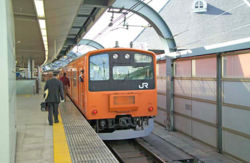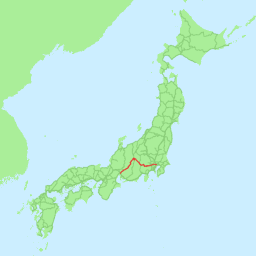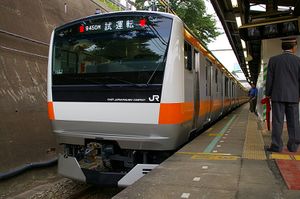Chūō Main Line
The Chūō Main Line (中央本線 Chūō-honsen?), commonly called the Chūō Line, is one of the trunk lines of JR, the intercity rail group in Japan. It runs between Tokyo and Nagoya, although it is the slowest railway connection between the two cities (the Tōkaidō Shinkansen is much faster).
The eastern portion is run by the East Japan Railway Company, while the western portion is run by the Central Japan Railway Company. The dividing point between the two jurisdictions is Shiojiri Station. Despite the huge urban areas at either end of the Chūō Line, its central portion is very lightly travelled: the Shiojiri-Nakatsugawa corridor is only served by bi-hourly trains.
Contents
History
The oldest portion of the Chūō Line is the segment from Shinjuku Station to Tachikawa Station, which dates back to 1889. The extension westward continued through the turn of the century, with Hachioji Station and eastern Yamanashi prefecture in 1901, and Kofu in 1903. The Nagoya-Shiojiri segment was completed by 1902, and connected to Kofu by 1905.
The section between Iidabashi Station and Nakano Station was the first urban electric railway in Japan.
Stations
Tokyo-Mitaka
The section between Tokyo and Mitaka is grade-separated, with no level crossings. Between Ochanomizu and Mitaka, the Chūō Main Line runs alongside the Chūō-Sōbu Line: the main line carries rapid service and express trains, while the Chūō-Sōbu Line carries local trains. The Tokyo-Shinjuku portion is a vital cross-town rail link, and also the city's best-known suicide location due to the high speed and cramped schedule of the trains. Chūō Main Line is called Chūō East Line (中央東線 Chūō Higashi sen?) between Tokyo and Shiojiri.
- Tokyo Station (東京)
- Kanda Station (神田)
- Ochanomizu Station (御茶ノ水)
- Suidobashi Station (水道橋)
- Iidabashi Station (飯田橋)
- Ichigaya Station (市ヶ谷)
- Yotsuya Station (四ツ谷)
- Shinanomachi Station (信濃町)
- Sendagaya Station (千駄ヶ谷)
- Yoyogi Station (代々木)
- Shinjuku Station (新宿)
- Okubo Station (大久保)
- Higashi-Nakano Station (東中野)
- Nakano Station (中野) (Tokyo Metro Tozai Line through trains)
- Koenji Station (高円寺)
- Asagaya Station (阿佐ヶ谷)
- Ogikubo Station (荻窪)
- Nishi-Ogikubo Station (西荻窪)
- Kichijoji Station (吉祥寺)
- Mitaka Station (三鷹) (Tokyo Metro Tozai Line Through train terminus)
Mitaka-Takao
Currently, construction is ongoing between Mitaka and Tachikawa to elevate the tracks and eliminate level crossings; this section of the line is notorious for its level crossings which can be shut for upwards of an hour during rush hour. Further plans have been proposed to add another two tracks as far as Tachikawa; however, this will not be included in the track elevation, due to be completed between 2008-2011.
- Mitaka Station (三鷹) (Tokyo Metro Tozai Line Through train terminus)
- Musashi-Sakai Station (武蔵境)
- Higashi-Koganei Station (東小金井)
- Musashi-Koganei Station (武蔵小金井)
- Kokubunji Station (国分寺)
- Nishi-Kokubunji Station (西国分寺)
- Kunitachi Station (国立)
- Tachikawa Station (立川)
- Hino Station (日野)
- Toyoda Station (豊田)
- Hachioji Station (八王子)
- Nishi-Hachioji Station (西八王子)
- Takao Station (高尾)
Takao-Kofu
The line from Takao to Kofu is served by local trains twice per hour during the day.
- Takao Station (高尾)
- Sagamiko Station (相模湖)
- Fujino Station (藤野)
- Uenohara Station (上野原)
- Shiotsu Station (四方津)
- Yanagawa Station (梁川)
- Torisawa Station (鳥沢)
- Saruhashi Station (猿橋)
- Otsuki Station (大月)
- Hatsukari Station (初狩)
- Sasago Station (笹子)
- Kai-Yamato Station (甲斐大和)
- Katsunuma-budokyo Station (勝沼ぶどう郷)
- Enzan Station (塩山)
- Higashi-Yamanashi Station (東山梨)
- Yamanashishi Station (山梨市)
- Kasugaicho Station (春日居町)
- Isawaonsen Station (石和温泉)
- Sakaori Station (酒折)
- Kofu Station (甲府)
Kofu - Shiojiri
The line from Kofu to Shiojiri is served by hourly local trains, most of which run past Shiojiri to Matsumoto Station.
- Kofu Station (甲府)
- Ryuo Station (竜王)
- Shiozaki Station (塩崎)
- Nirasaki Station (韮崎)
- Shinpu Station (新府)
- Anayama Station (穴山)
- Hinoharu Station (日野春)
- Nagasaka Station (長坂)
- Kobuchizawa Station (小淵沢)
- Shinano-Sakai Station (信濃境)
- Fujimi Station (富士見)
- Suzurannosato Station (すずらんの里)
- Aoyagi Station (青柳)
- Chino Station (茅野)
- Kamisuwa Station (上諏訪)
- Shimosuwa Station (下諏訪)
- Okaya Station (岡谷)
- Main Line:
- Midoriko Station (みどり湖)
- Old Line:
- Okaya Station (岡谷)
- Kawagishi Station (川岸)
- Tatsuno Station (辰野)
- Shinano-Kawashima Station (信濃川島)
- Ono Station (小野)
- Shiojiri Station (塩尻)
Shiojiri - Nakatsugawa
The line from Shiojiri to Nakatsugawa is the least trafficked on the Chūō Main Line, with local trains running every 2 hours during the day. Chūō Main Line is called Chūō West Line (中央西線 Chūo Nishi sen?) between Shiojiri and Nagoya.
- Shiojiri Station (塩尻)
- Seba Station (洗馬)
- Hideshio Station (日出塩)
- Niekawa Station (贄川)
- Kiso-Hirasawa Station (木曽平沢)
- Narai Station (奈良井)
- Yabuhara Station (藪原)
- Miyanokoshi Station (宮ノ越)
- Harano Station (原野)
- Kiso-Fukushima Station (木曽福島)
- Agematsu Station (上松)
- Kuramoto Station (倉本)
- Suhara Station (須原)
- Okuwa Station (大桑)
- Nojiri Station (野尻)
- Junikane Station (十二兼)
- Nagiso Station (南木曽)
- Tadachi Station (田立)
- Sakashita Station (坂下)
- Ochiaigawa Station (落合川)
- Nakatsugawa Station (中津川)
Nakatsugawa - Nagoya
Local and rapid service trains run on the line from Nakatsugawa to Nagoya.
- Nakatsugawa Station (中津川)
- Mino-Sakamoto Station (美乃坂本)
- Ena Station (恵那)
- Takenami Station (武並)
- Kamado Station (釜戸)
- Mizunami Station (瑞浪)
- Tokishi Station (土岐市)
- Tajimi Station (多治見)
- Kokokei Station (古虎渓)
- Jokoji Station (定光寺)
- Kozoji Station (高蔵寺)
- Jinryo Station (神領)
- Kasugai Station (春日井)
- Kachigawa Station (勝川)
- Shin-Moriyama Station (新守山)
- Ozone Station (大曽根)
- Chikusa Station (千種)
- Tsurumai Station (鶴舞)
- Kanayama Station (金山)
- Nagoya Station (名古屋)
Trains
New E233 series trains entered service on Tokyo-area commuter services from December 26, 2006. These trains are a development of the E231 series design used on other commuter lines in the Tokyo area, and will replace the aging 201 series rolling stock introduced on the line in 1981.
Long distance trains using the Chūō Line include:
- Azusa and Super Azusa limited express (Shinjuku - Matsumoto)
- Kaiji limited express (Tokyo or Shinjuku - Kofu - Ryuo)
- Hamakaiji limited express (Yokohama - Kofu - Ryuo)
- Shinano limited express (Osaka or Nagoya - Nagano)
- Misuzu rapid service (Iida - Nagano)
- Chikuma overnight express (Osaka - Nagano)
- Moonlight Shinshu overnight rapid service (Shinjuku - Matsumoto - Hakuba)
External links
Mass transit in Tokyo | |
|---|---|
| Metro lines (Subway) | Chiyoda · Fukutoshin · Ginza · Hanzōmon · Hibiya · Marunouchi · Namboku · Tōzai · Yūrakuchō |
| Toei lines | Subway: Asakusa · Mita · Ōedo · Shinjuku Streetcar: Arakawa |
| JR lines | Yamanote · Chūō · Chūō-Sōbu · Jōban · Keihin-Tōhoku · Keiyō · Saikyō · Shōnan-Shinjuku · Sōbu · Tōkaidō · Yokosuka |
| Other networks | Keikyū · Keiō · Keisei · Nippori-Toneri · Odakyū · Seibu · Tōbu · Tokyo Monorail · Tōkyū · TWR · TX · Yurikamome |
| Around Tokyo | Chiba Monorail · Enoden · Hokusō · Saitama Rapid · Saitama New Urban · Shin-Keisei · Shōnan Monorail · Sōtetsu · Tama Monorail · Tōyō Rapid · Yokohama MM · Yokohama Subway |
| Terminals | Asakusa · Ikebukuro · Kita-Senju · Oshiage · Shibuya · Shinagawa · Shinjuku · Tōkyō · Ueno |
| Miscellaneous | PASMO · Passnet · Suica · Transportation in Greater Tokyo |



